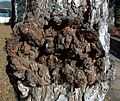Canker


Canker and anthracnose generally refer to many different plant diseases of such broadly similar symptoms as the appearance of small areas of dead tissue, which grow slowly, often over years. Some are of only minor consequence, but others are ultimately lethal and therefore of major economic importance in agriculture and horticulture. Their causes include such a wide range of organisms as fungi, bacteria, mycoplasmas and viruses. The majority of canker-causing organisms are bound to a unique host species or genus, but a few will attack other plants. Weather and animals can spread canker, thereby endangering areas that have only slight amount of canker.
Although fungicides or bactericides can treat some cankers, often the only available treatment is to destroy the infected plant to contain the disease thereto.
Examples
- Apple canker, caused by the fungus Neonectria galligena
- Ash bacterial canker, now understood to be caused by the bacterium Pseudomonas savastanoi, rather than Pseudomonas syringae. After DNA-relatedness studies Pseudomonas savastanoi has been instated as a new species.[1]
- Butternut canker, caused by the fungus Sirococcus clavigignenti-juglandacearum
- Bleeding Canker of Horse Chestnut, caused by the bacterium Pseudomonas syringae pv. aesculi
- Citrus canker, caused by the bacterium Xanthomonas axonopodis
- Cypress canker, caused by the fungus Seiridium cardinale
- Dogwood anthracnose, caused by the fungus Discula destructiva
- Grape canker, caused by the fungus Eutypa lata
- Honey locust canker, caused by the fungus Thyronectria austro-americana
- Mulberry canker, caused by the fungus Gibberella baccata
- Oak canker, caused by the fungus Diplodia quercina
- Pine pitch canker, caused by the fungus Fusarium pini
- Plane anthracnose, caused by the fungus Apiognomonia veneta
- Poplar canker, caused by the bacterium Xanthomonas populi
- Rapeseed stem canker, caused by the blackleg fungus Leptosphaeria maculans
- Rose cankers, caused by the fungus Leptosphaeria coniothyrium and Cryptosporella umbrina
- Scleroderris canker, caused by the fungus Gremmeniella abietina
- Willow anthracnose, caused by the fungus Marssonina salicicola
- Tomato anthracnose, caused by the fungus Colletotrichum coccodes
-

Canker on a birch
-
Canker on a Beech tree.
-
Canker on an Ash tree in North Ayrshire, Scotland.
-

Birch canker discovered in Port Elgin, Ontario.
References
- ↑ Gardan, L.; Shafik, H.; Belouin, S.; Broch, R.; Grimont, F.; Grimont, P. A. D. (1999). "DNA relatedness among the pathovars of Pseudomonas syringae and description of Pseudomonas tremae sp. nov. and Pseudomonas cannabina sp. nov. (ex Sutic and Dowson 1959)". International Journal of Systematic Bacteriology 49: 469–78. DOI Digital object identifier:10.1099/00207713-49-2-469. http://ijs.sgmjournals.org/content/49/2/469 PMID 10319466.
See also
- Forest Pathology
- Cancer
- Tumor

